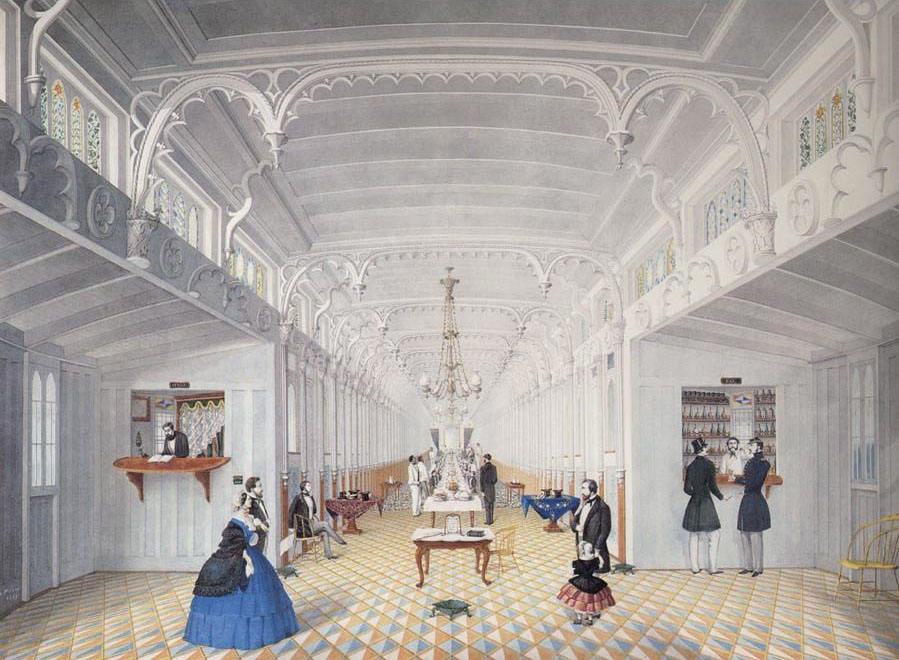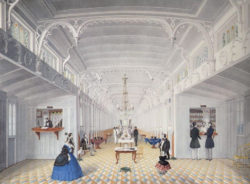Marie Adrien Persac
Painter, photographer, surveyor, lithographer, and inventor Marie Adrien Persac was the most important delineator of plantatino scenes in nineteenth-century Louisiana.

Courtesy of The Historic New Orleans Collection
Steamboat Princess. Persac, Marie Adrien (Artist)
The French-born painter, photographer, surveyor, lithographer and inventor Marie Adrien Persac was the most important delineator of plantation scenes in nineteenth-century Louisiana. In addition to painting some thirty idealized plantation scenes and public buildings in gouache for private clients, Persac also worked in traditional watercolors, depicting houses for the auction market in New Orleans. While the painter also offered his talents as a teacher of art, photographer, and lithographer, his most well known and reproduced work, the five-foot Norman’s Chart of the Lower Mississippi River (1858), is an engraving made from his original gouache.
Born into a politically prominent family in Saumur, a commune in the Maine-et-Loire Department of western France, Persac was one of thousands of French emigrants who influenced the culture of Louisiana in the nineteenth century. Family tradition states that he tried apple growing in the U.S. before 1850, using inherited money. Moving from Indiana to Louisiana for reasons unknown, Persac apparently met and in 1851 married Mary Odile Daigre (1834-1917), the daughter of a prosperous Manchac, Louisiana farmer. The couple initially resided at her family home south of Baton Rouge.
In 1856 Persac, with partner William Vail, opened his first known gallery, a daguerreotype photographic studio in a prominent building on Florida Avenue in Baton Rouge. Advertising heavily in the Baton Rouge Daily Advocate, the partners indicated that they had studied “the art in its various branches” at galleries in New York City and Washington, D.C. After thanking the public for its “liberal patronage,” the partnership dissolved in a season.
In 1857, Persac embarked upon a remarkable four-year span of studying, dissecting, and painting Louisiana plantation scenes. He descended the Mississippi River from Natchez, Mississippi, to New Orleans, cataloging all of the plantations along the way. His subsequent chart of the estates and owners along the river also contains vignettes of Baton Rouge, New Orleans, and sugar and cotton plantations. It first appeared in 1858 as an engraving by J. H. Colton & Co. of New York City, published by B.M. Norman.
Norman’s Chart both familiarized Persac with the lower Mississippi and familiarized the public with his work. Within three years, the painter received commissions from plantation owners along the Mississippi, in the Bayou Teche area, in New Orleans, and in Baton Rouge. Working with the precision of a miniaturist, he painted manor houses along with their dependencies, farm animals, crop rows, sugar houses, trees, and fences. He populated these scenes with fashionably attired owners, their servants and animals. Some of the figures he drew and painted; others he famously pasted on as collage figures, cut out from high-fashion magazines.
One of Persac’s subtle techniques was to relegate his principal buildings to his middle grounds, leaving considerable space for foreground objects. For example, a painting of the James N. Brown house Manchac lies across some fence lines and down the road from the point of the viewer. The houses of Orange Grove in St. Mary Parish rise well across a bayou and shadowy bank line. Palo Alto in Ascension Parish is a half-mile away, beyond the Mississippi, two bank lines, and a road. A grass-covered hill in the foreground of the Prairie Sorrel home and sawmill in Lafayette Parish accommodates three groups of sheep, then descends to a pond where cattle are wading before a fence line that defines the mill site.
Hidden in plain view, the busy foregrounds then function to direct the eye of the viewer. Their parallel fence and bank lines set on diagonals align perspective and frame the focal points. The principal houses and trees thus placed in the middle ground allowed Persac to draw them as stylized miniatures on canvasses averaging nearly twenty inches wide and proportionately high. Cleverly, it also scaled them down to the painter’s cut-out figures. It allowed for a wide perspective, as with Balzamine in Terrebonne Parish, where a modest three-bay residence nestles inside an Elysian paradise of trees and shrubbery. Analyzing these schemes, a viewer may come to the conclusion of being pleasantly manipulated.
The Civil War put an end both to the resources of Persac’s clients and to the comfortable message he was peddling them. Having moved to New Orleans, he entered the property recordation market, completing some forty-three watercolor drawings for New Orleans lots and houses offered at court-ordered auctions. Working frequently with fellow surveyor Eugene Surgi, he became one of the system’s three most accomplished artists, continuing this work until 1869. Today his notarial “Plan Book drawings” exhibit his tried techniques of using parallel pointers, colorful minutia, expert perspective, and even cut-out figures to charm and attract the eye of the potential auction bidder.
Returning after 1865 to his early career as a photographer, Persac entered another partnership. Pursuing the artist’s market in a struggling economy, he also completed the work for a series of lithographs of city scenes and businesses. By 1872, Persac had become so prominent in New Orleans that the Russian Grand Duke Alexis, at the time of his visit, presented him with a diamond-encrusted ruby ring in exchange for the gift of a pencil drawing of the city. The next year, Persac began to compile a series of Canal Street views in grisaille, each a view of a block of business establishments. He had almost completed this series in 1873 when he met an untimely and unexpected death at the age of fifty.
Persac was one of the most important of the “Foreign French” artists who settled in Louisiana during the nineteenth century. Although his work made him more prominent than wealthy, he bequeathed the state a wealth of art and documentation of life in nineteenth-century Louisiana.
